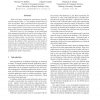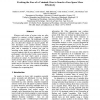2663 search results - page 12 / 533 » How to Choose a Timing Model |
ACL
1994
13 years 8 months ago
1994
This paper shows how to formally characterize language learning in a finite parameter space as a Markov structure, hnportant new language learning results follow directly: explici...
TIME
2006
IEEE
14 years 1 months ago
2006
IEEE
Published in: Proceedings of the 13th International Symposium on Temporal Representation and Reasoning (TIME-06), Budapest, Hungary, June 2006. IEEE Computer Society Press. Real-w...
BLISS
2007
IEEE
14 years 1 months ago
2007
IEEE
Witnesses and victims of serious crime are often required to construct a facial composite, a visual likeness of a suspect’s face. The traditional method is for them to select in...
WWW
2007
ACM
14 years 8 months ago
2007
ACM
Previous studies comparing the prediction accuracy of effort models built using Web cross- and single-company data sets have been inconclusive, and as such replicated studies are ...
HYBRID
2004
Springer
14 years 27 days ago
2004
Springer
In this paper, we introduce a parametric semantics for timed controllers called the Almost ASAP semantics. This semantics is a relaxation of the usual ASAP3 semantics (also called ...


